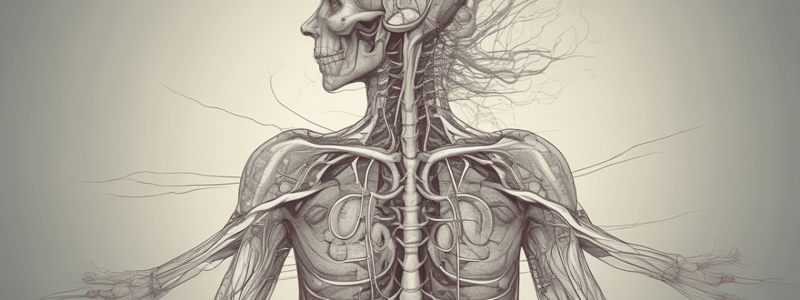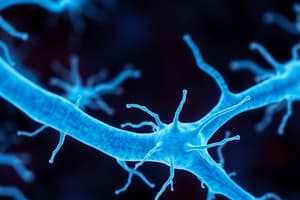Podcast
Questions and Answers
Which structures comprise the central nervous system (CNS)?
Which structures comprise the central nervous system (CNS)?
- Peripheral nerves and nerve ganglia
- Neuron cell bodies and synapses
- Dendrites and axons
- Brain and spinal cord (correct)
What is the primary function of astrocytes in the central nervous system?
What is the primary function of astrocytes in the central nervous system?
- Makes myelin
- Provides structural support and participates in the blood-brain barrier (correct)
- Eats up debris and dead cells
- Lines cavities of the CNS
Which statement about neurons is correct?
Which statement about neurons is correct?
- Neurons lack a cytoskeleton
- The cell body can receive synaptic input (correct)
- Neurons are the least abundant cell type in the brain
- Neurons can have multiple axons but only one dendrite
What is the main role of oligodendrocytes in the nervous system?
What is the main role of oligodendrocytes in the nervous system?
How do Schwann cells differ from oligodendrocytes?
How do Schwann cells differ from oligodendrocytes?
Which glial cell type is responsible for consuming debris and dead cells?
Which glial cell type is responsible for consuming debris and dead cells?
What is a common characteristic of the structures involved in the peripheral nervous system?
What is a common characteristic of the structures involved in the peripheral nervous system?
What specific feature originates at the axon hillock of a neuron?
What specific feature originates at the axon hillock of a neuron?
What is the primary function of Nissl substance in a neuron?
What is the primary function of Nissl substance in a neuron?
Which of the following is NOT a function of astrocytes?
Which of the following is NOT a function of astrocytes?
What is the significance of the axon hillock in a neuron?
What is the significance of the axon hillock in a neuron?
Which of the following statements accurately describes the relationship between neurons and glial cells?
Which of the following statements accurately describes the relationship between neurons and glial cells?
Which type of glial cell is primarily responsible for forming myelin sheaths in the peripheral nervous system?
Which type of glial cell is primarily responsible for forming myelin sheaths in the peripheral nervous system?
What is the main difference between the central nervous system (CNS) and the peripheral nervous system (PNS)?
What is the main difference between the central nervous system (CNS) and the peripheral nervous system (PNS)?
Which of these structures is NOT part of a neuron?
Which of these structures is NOT part of a neuron?
Which of the following best describes the role of microtubules in a neuron?
Which of the following best describes the role of microtubules in a neuron?
Flashcards are hidden until you start studying
Study Notes
Nervous System Organization
- The nervous system consists of the central nervous system (CNS) and the peripheral nervous system (PNS)
- CNS includes the brain and spinal cord
- PNS includes peripheral nerves and nerve ganglia (groups of nerve cell bodies outside the CNS)
- PNS has motor and sensory components
Neurons
- Cell body maintains the cell and receives synaptic input
- Tons of Nissl substance (rough ER) present in the cell body
- Multiple dendrites receive impulses
- One axon originates at the "axon hillock" and sends out impulses
- Cytoskeleton contains neurofilaments (for structure) and microtubules (for transport along axons)
- Large pale nucleus with a nucleolus present
Glial Cells
- 10 times more abundant than neurons in the brain
- Support and protect neurons
- Five types of glial cells with different functions:
- Astrocyte: provides structural support, participates in blood-brain barrier, and is located in the CNS
- Oligodendrocyte: makes myelin and is located in the CNS
- Schwann cell: makes myelin and is located in the PNS
- Ependymal cell: lines cavities of CNS
- Microglial cell: eats up debris and dead cells, and is located in the CNS
Additional Facts
- Astrocyte foot processes bind to capillaries and neurons
- Neuropil is a region where neurons and glial cells interact
Nervous System Organization
- The nervous system consists of the central nervous system (CNS) and the peripheral nervous system (PNS)
- CNS includes the brain and spinal cord
- PNS includes peripheral nerves and nerve ganglia (groups of nerve cell bodies outside the CNS)
- PNS has motor and sensory components
Neurons
- Cell body maintains the cell and receives synaptic input
- Tons of Nissl substance (rough ER) present in the cell body
- Multiple dendrites receive impulses
- One axon originates at the "axon hillock" and sends out impulses
- Cytoskeleton contains neurofilaments (for structure) and microtubules (for transport along axons)
- Large pale nucleus with a nucleolus present
Glial Cells
- 10 times more abundant than neurons in the brain
- Support and protect neurons
- Five types of glial cells with different functions:
- Astrocyte: provides structural support, participates in blood-brain barrier, and is located in the CNS
- Oligodendrocyte: makes myelin and is located in the CNS
- Schwann cell: makes myelin and is located in the PNS
- Ependymal cell: lines cavities of CNS
- Microglial cell: eats up debris and dead cells, and is located in the CNS
Additional Facts
- Astrocyte foot processes bind to capillaries and neurons
- Neuropil is a region where neurons and glial cells interact
Studying That Suits You
Use AI to generate personalized quizzes and flashcards to suit your learning preferences.




